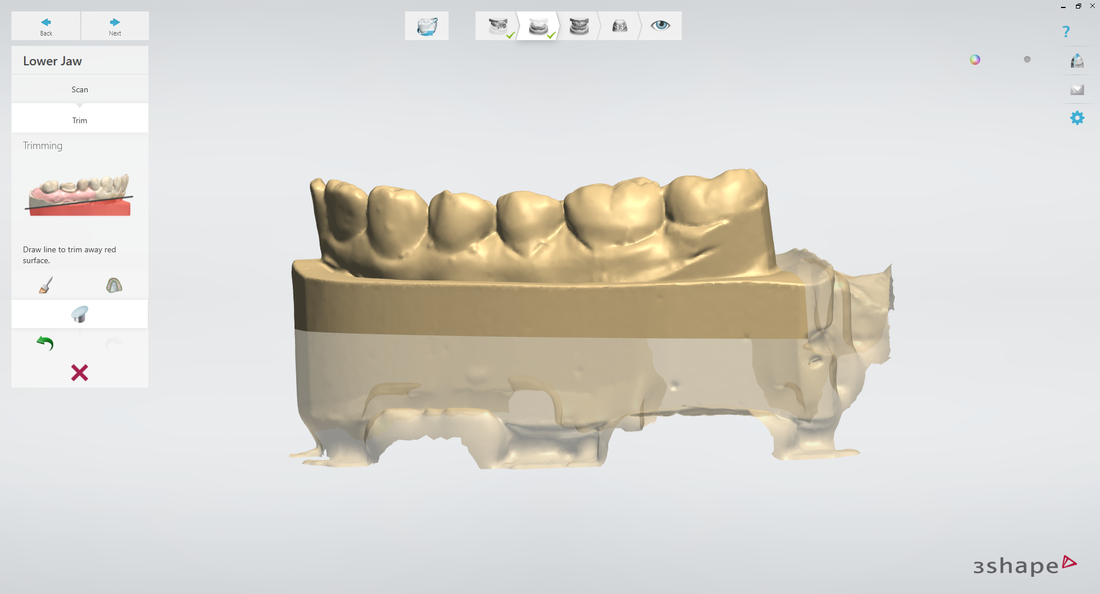|
Market research conducted by Fact.MR found that the global market for three-dimensional (3D) dental scanners is anticipated to reach a value of $ 2.5 billion United States Dollars (USD) by the end of 2027. In addition, a report published by Allied Market Research found the market to be estimated at $834.63 million in 2020 with the expectation to reach $4.77 billion by 2030. The compound annual growth rate (CAGR) is estimated to grow by 15.9% by 2030. WHAT ARE INTRAORAL SCANNERS?Intraoral scanners (IOS) are small, handheld, intraoral appliances that scan and examine the inside of a patient’s mouth and teeth. Paired with 3D dental imaging, the scanners capture multiple images in real-time and send them directly to a computer to display them in a 3D format. 3D scans provide a clear and concise picture of the abnormalities or diseases that cannot be seen with the naked eye. The images produced can be used to prepare for dental procedures and to assess the effectiveness of the treatment or restoration. These new-age digital dental scanners replace traditional impergum or alginate impressions, providing an accurate, to-scale representation of the teeth, occlusion, and bite. Dentists are able to safely and quickly diagnose patients and provide individualized treatment. While traditional impression-taking employs impression trays, new-age 3D intraoral scanners are more practical and pleasant to use. Dentists can scan upper, lower, and jaw impressions with ease while capturing the textures and hues of the original teeth. They have the ability to scan the full dental arch in less than 3 minutes without the need for trays or plates. Because of the digital workflow, scans can be processed immediately and dentists can forward the digital files directly to their labs and receive a response quickly. Key suppliers of 3D digital impression scanners are consistently introducing new products with specialized and specific end-uses, and top companies are collaborating to expand the reach of their products. HISTORY OF 3D DENTAL SCANSCone beam computed tomography (CBCT) was the first form of 3D dental scanning that was introduced by German dentist, Otto Walkhoff in the late 1990s. Walkhoff made the first dental radiograph and recorded it by holding a glass receptor in his mouth while lying on the floor with a 25-minute exposure. KEY TAKEAWAYS FROM MARKET STUDYBoth market studies conducted by Fact.MR and Allied Market Research analyzed the drivers and opportunities, market size and estimations, the competitive landscape, and the evolving market trends of 3D dental scanners globally. Key findings and estimations:
FACTORS FOR THE INCREASING DEMAND FOR INTRAORAL SCANNERSThere are many factors that contribute to the rising market of 3D dental intraoral scanners, including advancements in technology, aging populations, growing awareness regarding oral health, a rise in oral disorders, and the increasing demand for cosmetic dentistry. Constant innovations and advancements in dental technology heavily impact the 3D dental scanners market. Dental diagnostic imaging equipment has helped to expand the field of dental healthcare and the increase in data and technological solutions has made dental processes faster, more effective, and more efficient. With such technical advancements, the ability of digital systems to reduce diagnosis time and improve image quality has made getting access to education regarding oral health more convenient. Computer-aided manufacturing and design allow for individualization and customization for the specific case and patient. Diagnostics, decision-making, therapy administration, and evaluation are made easier for the dentist and patient and made more accurate thanks to the rising adoption of CBCT and 3-D imaging systems. Moreover, the geriatric population is expanding rapidly worldwide, leading to growth in disorders such as edentulism and tooth deterioration or loss. A likely factor in the heightening demand for 3D dental scanning is that older people are more susceptible to oral health conditions because they are unlikely to maintain their oral health due to personal habits, disabilities, or lack of insurance. Habitual smokers who are 50 years plus are less likely to pursue dental care than non-smokers. In addition, those are who disabled, homebound, or institutionalized are more likely to have poor oral health. Lastly, many of the geriatric population lack dental insurance because they lost benefits upon retirement. Routine dental care is not covered by federal Medicare. Oral health problems that affect older adults the most include untreated tooth decay, gum disease, tooth loss, oral cancer, and chronic disease. Additionally, older people are more likely to experience pain and discomfort during scanning processes, but digitalization has made oral healthcare more accessible to all groups of people, and it has also made it more comfortable with its ease of use and portability. Furthermore, awareness regarding oral health has increased–especially in the United States. Thanks to efforts from the American Dental Association (ADA) to promote oral health care and oral disease prevention, people are now more inclined to take care of their teeth than they were before. Collaborating with key market players to raise awareness of dental products, potential diseases, and damages, the government has progressively been launching pro-dental care campaigns. In addition, tax benefits are also provided to those key market players globally. However, despite the endeavors of the ADA and other promotional groups, dental hygiene and disease prevention are not typically considered to be healthcare concerns. Globally, poor oral health is on the rise, and the increase in dental disorders is one of the many fueling factors augmenting the surging 3D dental scanning market. According to the World Health Organization (WHO), approximately 3.58 billion people worldwide suffer from oral disease with 10% enduring severe gum disorders that can lead to tooth loss. Diseases such as dental caries, oro-dental trauma, oral cancer, and gum disease, among others, pose a major health burden all over the world. The primary causes are ignorance of oral issues and increased sugar consumption. With this, the demand for dental imaging has increased to address the rising number of tooth decay cases. On the other hand, the millennial generation’s unhealthy lifestyle has drastically influenced the sugar consumption rate worldwide. One of the most prominent causes of dental cavities is high sugar intake. Packaged foods and desserts are becoming increasingly popular because of the steady growth of disposable income. In turn, dental issues have noticeably increased and driven the dental imaging market. Lastly, the surging demand for cosmetic dentistry has a high correlation to digital dental market opportunities. The rise in disposable income and beauty standards has helped to drive cosmetic dentistry. Body modifications are growing in popularity and the desire for perfect teeth comes with it. Sources: Huge Potential for Laboratory 3D Dental Scanners in Digital Dentistry: Fact.MR Study What is a 3D Dental Scan? Intraoral Scanners Market Is Expected to Reach USD 4.77 Billion by 2030 Digital Dental Imaging Market Keywords:
The Dental Lab, restoration, digital dental scanner, digital dental scanners, 3D scanners, dental scanning, digital, oral disease, cad/cam, technology, itero, digital scanner, digital scanners, digital dental impression, digital dental impressions, digital impression scanner, digital impression scanners
0 Comments
Leave a Reply. |



